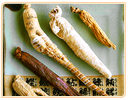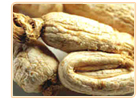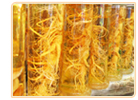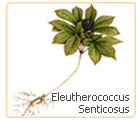Types of Ginseng
 There are several types of ginseng that grow all over the world, from Ontario in Canada to the mountains of China. The most well known types of ginseng, like Panax (Asian ginseng, white ginseng, and red ginseng) and Panax Quinquefolius (Wild ginseng), grow in more temperate regions. But there are a range of types of root and plant growing around the globe. There are several types of ginseng that grow all over the world, from Ontario in Canada to the mountains of China. The most well known types of ginseng, like Panax (Asian ginseng, white ginseng, and red ginseng) and Panax Quinquefolius (Wild ginseng), grow in more temperate regions. But there are a range of types of root and plant growing around the globe.
Despite differing in appearance, all types of ginseng are considered to have significant health benefits. This is even true of the remarketed Eleutherococcus Senticosus or Siberian ginseng, which doesn't belong to the ginseng family. Keep reading to learn more about the main types of ginseng:
Panax:
 In traditional Chinese medicine, Panax or Asian ginseng (root) is believed to promote Yang energy. Such energy improves circulation and stimulates the body. This particular type of ginseng is grown in various parts of Eastern Asia, Korea, and Russia, and is an adaptogen - a type of herb which has the ability to relax the body and improve the immune system. In its mature white form, Panax is high in ginsenosides - the chemical compounds that provide most of its health benefits. In traditional Chinese medicine, Panax or Asian ginseng (root) is believed to promote Yang energy. Such energy improves circulation and stimulates the body. This particular type of ginseng is grown in various parts of Eastern Asia, Korea, and Russia, and is an adaptogen - a type of herb which has the ability to relax the body and improve the immune system. In its mature white form, Panax is high in ginsenosides - the chemical compounds that provide most of its health benefits.
Panax Quinquefolius:
 The American version of the Panax root family can be thought of as the �Ying� that complements Asian ginseng, the �Yang�. It grows in certain American states, such as Wisconsin as well as in the Canadian province of Ontario. Panax Quinqufolius calms the body and gets rid of any surplus Yang energy. More clinical studies have been carried out on American ginseng than Panax, and its effects on the human body are significantly more conclusive. The American version of the Panax root family can be thought of as the �Ying� that complements Asian ginseng, the �Yang�. It grows in certain American states, such as Wisconsin as well as in the Canadian province of Ontario. Panax Quinqufolius calms the body and gets rid of any surplus Yang energy. More clinical studies have been carried out on American ginseng than Panax, and its effects on the human body are significantly more conclusive.
Red Ginseng:
 Red ginseng (a dried form of white ginseng) gets its name from its distinctive appearance, which develops after being heated, steamed or sun dried. Its brittle texture is a result of it being marinated for herbal brews. Red ginseng is most commonly used to increase energy and treat sexual dysfunction problems. Red ginseng (a dried form of white ginseng) gets its name from its distinctive appearance, which develops after being heated, steamed or sun dried. Its brittle texture is a result of it being marinated for herbal brews. Red ginseng is most commonly used to increase energy and treat sexual dysfunction problems.
Wild Ginseng:
 Because ginseng is highly sought-after, most ginseng growth occurs on specially maintained farms. Thus, "Wild ginseng" refers to a version of the root that has grown without any human interference. Because ginseng is highly sought-after, most ginseng growth occurs on specially maintained farms. Thus, "Wild ginseng" refers to a version of the root that has grown without any human interference.
Siberian Ginseng:
 Siberian ginseng (Eleutherococcus Senticosus) shares many qualities with the Panax family of ginseng. It is known as Eleuthero because its active beneficial chemical ingredient is eleutherosides and not ginsenosides. Like Panax ginseng, Siberian ginseng is classified as an adaptogen, meaning it relaxes the body. It's also used as a mild anti-inflammatory, anticholestermic , antioxidant, and immune tonic. Therefore, it's used to treat a wide array of ailments. Siberian ginseng (Eleutherococcus Senticosus) shares many qualities with the Panax family of ginseng. It is known as Eleuthero because its active beneficial chemical ingredient is eleutherosides and not ginsenosides. Like Panax ginseng, Siberian ginseng is classified as an adaptogen, meaning it relaxes the body. It's also used as a mild anti-inflammatory, anticholestermic , antioxidant, and immune tonic. Therefore, it's used to treat a wide array of ailments.
Korean Ginseng:
 Panax ginseng is sometimes referred to as "Korean ginseng" because it grows in various parts of the country. Korean ginseng is a deciduous perennial herb that, at full maturity, is 60 to 80 cm tall, with a typically light colored, fleshy root. The health benefits of ginseng stem from the root of the plant, which, at maturity, contains a high percentage of the chemical ginsenoside. Panax ginseng is sometimes referred to as "Korean ginseng" because it grows in various parts of the country. Korean ginseng is a deciduous perennial herb that, at full maturity, is 60 to 80 cm tall, with a typically light colored, fleshy root. The health benefits of ginseng stem from the root of the plant, which, at maturity, contains a high percentage of the chemical ginsenoside.
Although different types of ginseng exist, traditionally they have all been used as preventative medicine, and they all have therapeutic benefits. If taken regularly ginseng enhances vitality, and is reputed to lengthen life span.
Now that it is understood what different types of ginseng are available. Please continue reading to learn more about how ginseng works.
Conclusions about the Types of Ginseng
Although different types of ginseng have been used to treat some menopause symptoms, it has recently been criticized because it adds artificial hormones to the body. In doing so, ginseng can trigger side effects including serious conditions such as breast cancer.
Other alternative treatments are just as effective as ginseng, but without the side effects. Non-estrogenic herbs, for example, are a great option for treating menopause symptoms. Read more in the following article.
Which herb should women try? Today women are looking for relief from their menopause symptoms with herbs. Phytoestrogenic herbs and non-estrogenic herbs are good in relieving menopause symptoms, but recent studies show that non-estrogenic herbs have no side effects because they help the body to produce its own hormones instead of introducing hormones like the phytoestrogenic ones. Learn more about non-estrogenic herbs for menopause.
| 

